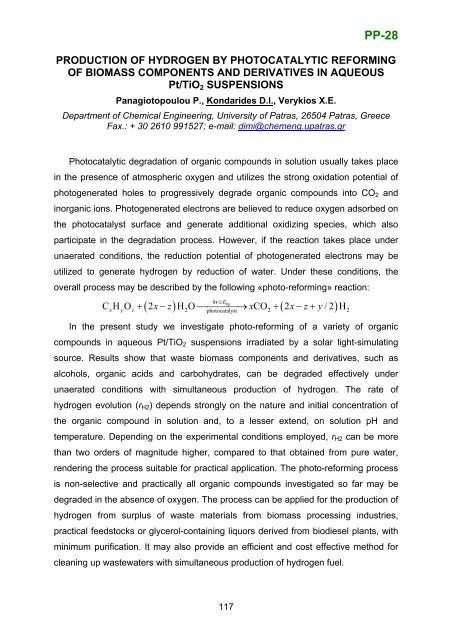Boreskov Institute of Catalysis SB RAS, Novosibirsk, Russia
Boreskov Institute of Catalysis SB RAS, Novosibirsk, Russia
Boreskov Institute of Catalysis SB RAS, Novosibirsk, Russia
- No tags were found...
Create successful ePaper yourself
Turn your PDF publications into a flip-book with our unique Google optimized e-Paper software.
PP-28PRODUCTION OF HYDROGEN BY PHOTOCATALYTIC REFORMINGOF BIOMASS COMPONENTS AND DERIVATIVES IN AQUEOUSPt/TiO 2 SUSPENSIONSPanagiotopoulou P., Kondarides D.I., Verykios X.E.Department <strong>of</strong> Chemical Engineering, University <strong>of</strong> Patras, 26504 Patras, GreeceFax.: + 30 2610 991527; e-mail: dimi@chemeng.upatras.grPhotocatalytic degradation <strong>of</strong> organic compounds in solution usually takes placein the presence <strong>of</strong> atmospheric oxygen and utilizes the strong oxidation potential <strong>of</strong>photogenerated holes to progressively degrade organic compounds into CO 2 andinorganic ions. Photogenerated electrons are believed to reduce oxygen adsorbed onthe photocatalyst surface and generate additional oxidizing species, which alsoparticipate in the degradation process. However, if the reaction takes place underunaerated conditions, the reduction potential <strong>of</strong> photogenerated electrons may beutilized to generate hydrogen by reduction <strong>of</strong> water. Under these conditions, theoverall process may be described by the following «photo-reforming» reaction:hν ≥E ( )bg( )CHOx y z+ 2x−z HO⎯⎯⎯⎯→ xCO + 2 x− z+ y/2 H22 photocatalyst2In the present study we investigate photo-reforming <strong>of</strong> a variety <strong>of</strong> organiccompounds in aqueous Pt/TiO 2 suspensions irradiated by a solar light-simulatingsource. Results show that waste biomass components and derivatives, such asalcohols, organic acids and carbohydrates, can be degraded effectively underunaerated conditions with simultaneous production <strong>of</strong> hydrogen. The rate <strong>of</strong>hydrogen evolution (r H2 ) depends strongly on the nature and initial concentration <strong>of</strong>the organic compound in solution and, to a lesser extend, on solution pH andtemperature. Depending on the experimental conditions employed, r H2 can be morethan two orders <strong>of</strong> magnitude higher, compared to that obtained from pure water,rendering the process suitable for practical application. The photo-reforming processis non-selective and practically all organic compounds investigated so far may bedegraded in the absence <strong>of</strong> oxygen. The process can be applied for the production <strong>of</strong>hydrogen from surplus <strong>of</strong> waste materials from biomass processing industries,practical feedstocks or glycerol-containing liquors derived from biodiesel plants, withminimum purification. It may also provide an efficient and cost effective method forcleaning up wastewaters with simultaneous production <strong>of</strong> hydrogen fuel.117
















